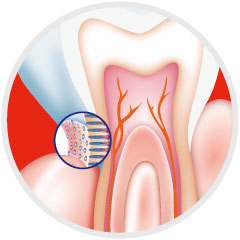 The oral cavity contains over 500 different microorganisms. This is why it is truly important to keep tabs on your teeth and gums regularly. It is very hard to distinguish exactly which periodontal pathogen is causing the breakdown of tissues and bone. There are different stages of periodontal disease as shown below.
The oral cavity contains over 500 different microorganisms. This is why it is truly important to keep tabs on your teeth and gums regularly. It is very hard to distinguish exactly which periodontal pathogen is causing the breakdown of tissues and bone. There are different stages of periodontal disease as shown below.
Gingivitis
The early stage of gum disease is called gingivitis and manifests itself by inflammation of the soft tissue in the mouth surrounding the teeth. Symptoms of gingivitis include swelling of the soft tissue, bleeding during/after brushing, and bad breath. In most cases, persistent bad breath accompanies gingivitis and cannot removed by brushing alone. Continuous bad taste in the mouth may also indicate the presence of gingivitis, but may also have gastrointestinal origins as well. At this stage, gingivitis produces subtle signs that can usually only be detected by a trained professional, such as a dentist or hygienist.
Gum Disease
 Gum disease is primarily caused by accumulation of plaque and tartar. Bacteria and plaque buildup attack the connective tissue attaching the teeth to the bones of the upper and lower arches. This periodontal attachment plays a crucial role in the stability and health of the teeth. If not treated properly, the condition advances into the further stages of gum disease called periodontitis. The presence and progression of periodontal disease can only be properly diagnosed by a dentist. Our dentists and hygienists will continue to monitor the condition at follow-up appointments, in conjunction with radiographs and visual exams. Of course, the best way to prevent gum disease is to prevent plaque buildup by scheduling regular teeth cleanings with one of our hygienists.
Gum disease is primarily caused by accumulation of plaque and tartar. Bacteria and plaque buildup attack the connective tissue attaching the teeth to the bones of the upper and lower arches. This periodontal attachment plays a crucial role in the stability and health of the teeth. If not treated properly, the condition advances into the further stages of gum disease called periodontitis. The presence and progression of periodontal disease can only be properly diagnosed by a dentist. Our dentists and hygienists will continue to monitor the condition at follow-up appointments, in conjunction with radiographs and visual exams. Of course, the best way to prevent gum disease is to prevent plaque buildup by scheduling regular teeth cleanings with one of our hygienists.
Periodontitis
The next stage of gum disease is called periodontitis. As the disease progresses down the tooth root towards the apex or tip of the root, the epithelium and alveolar bone becomes affected. Genetic and systemic factors typically play a role along with bacterial plaque leading to the formation of inflamed gingival pockets, harboring pathogenic organisms and triggers bone loss. The teeth become mobile and are eventually removed if no treatment is done. The tooth mobility is measured if the periodontal disease is advanced. Since bacterial plaque is usually the reason for the development of periodontal disease, the main focus is placed on antimicrobial strategies provided by our dentist or hygienist, such as scaling and root planing, in combination with diligent oral hygiene regimens.
Advanced Periodontitis
If non-surgical therapies fail to work, or a patient needs an alternate solution, a surgical method may be needed. These measures are usually taken in severe cases of chronic periodontitis. or bone loss. The patient may be referred to a periodontist specialist for further treatment, however, patients usually respond well to non-surgical methods.
 Advanced Smile Institute can help patients in need of periodontal disease treatment in Port St. Lucie, FL starting with a free consultation or initial exam, cleaning and x-ray appointment. Dr. Robert Lens offers convenient hours, competitive prices and preventative dental care services for all ages. All available treatment plans are custom tailored to each and every one of our patients. If you are looking to find a dentist or periodontist in Port St Lucie, we urge you to schedule your first visit at Advanced Smile Institute and meet our friendly staff of dental professionals.
Advanced Smile Institute can help patients in need of periodontal disease treatment in Port St. Lucie, FL starting with a free consultation or initial exam, cleaning and x-ray appointment. Dr. Robert Lens offers convenient hours, competitive prices and preventative dental care services for all ages. All available treatment plans are custom tailored to each and every one of our patients. If you are looking to find a dentist or periodontist in Port St Lucie, we urge you to schedule your first visit at Advanced Smile Institute and meet our friendly staff of dental professionals.
